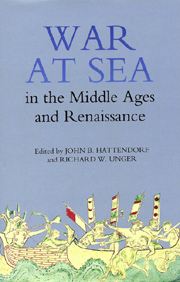Book contents
- Frontmatter
- Contents
- List of illustrations
- List of Contributors
- Preface
- Acknowledgements
- Introduction: Theories of Naval Power: A. T. Mahan and the Naval History of Medieval and Renaissance Europe
- I Northern Europe
- II Southern Europe
- Byzantium and the Sea: Byzantine Fleets and the History of the Empire in the Age of the Macedonian Emperors, c.900–1025 CE
- Iberian Naval Power, 1000–1650
- Venice, Genoa and Control of the Seas in the Thirteenth and Fourteenth Centuries
- Genoese Naval Forces in the Mediterranean during the Fifteenth and Sixteenth Centuries
- An Exemplary Maritime Republic: Venice at the End of the Middle Ages
- III Sixteenth and Early-Seventeenth-Century Europe
- Conclusion: Toward a History of Medieval Sea Power
- Index
- Titles in the series
Iberian Naval Power, 1000–1650
from II - Southern Europe
Published online by Cambridge University Press: 05 April 2013
- Frontmatter
- Contents
- List of illustrations
- List of Contributors
- Preface
- Acknowledgements
- Introduction: Theories of Naval Power: A. T. Mahan and the Naval History of Medieval and Renaissance Europe
- I Northern Europe
- II Southern Europe
- Byzantium and the Sea: Byzantine Fleets and the History of the Empire in the Age of the Macedonian Emperors, c.900–1025 CE
- Iberian Naval Power, 1000–1650
- Venice, Genoa and Control of the Seas in the Thirteenth and Fourteenth Centuries
- Genoese Naval Forces in the Mediterranean during the Fifteenth and Sixteenth Centuries
- An Exemplary Maritime Republic: Venice at the End of the Middle Ages
- III Sixteenth and Early-Seventeenth-Century Europe
- Conclusion: Toward a History of Medieval Sea Power
- Index
- Titles in the series
Summary
AT the beginning of the eleventh century, one would have assumed the future naval power of the Iberian Peninsula would be the Caliphate of Cordoba. The Christian kingdoms of Castile, Aragon and the counties of Catalonia, were small entities restricted to the northern portion of the peninsula, while the kingdom of Portugal did not yet exist. The Caliphate of Cordoba on the other hand had a highly developed naval organisation, due in large part to the Viking raids of 844. In that year a fleet of approximately a hundred longships attacked and sacked Lisbon, Seville, Cadiz, Medina Sidonia, and Algeciras. They were eventually driven off, but the raids had made an impact on the Muslim government. The response was to establish permanent arsenals and squadrons at the coastal cities along with a series of coastal watchtowers. When the Vikings returned in 859 they found the Caliphate to be a much tougher opponent and, though able to sack Algeciras, they suffered a series of defeats that discouraged them from ever returning in force.
By 1000 a sophisticated naval administration had developed in the caliphate headed by the amir al-bahr, who was responsible for the administration of the port squadrons and the arsenals. As such the admiral was responsible for the security of the entire coastline. The breakup of the caliphate in 1002 saw the office of the amir al-bahr disappear, although it would reappear under the later Muslim administrations of the Almoravids and the following Almohads.
- Type
- Chapter
- Information
- War at Sea in the Middle Ages and the Renaissance , pp. 105 - 118Publisher: Boydell & BrewerPrint publication year: 2002

